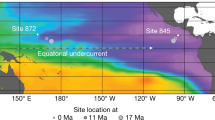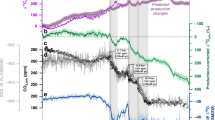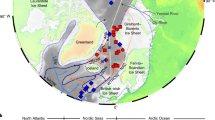Abstract
Causes of change in deep water δ13C can be either global or local in extent. Global causes include (1) climatically-induced changes in the amount of terrestrial biomass which alter the average carbon isotopic composition of the oceanic reservoir1, and (2) erosion and deposition of organic-rich, continental shelf sediments during sea level fluctuations which change the mean oceanic carbon: phosphorus ratio2. Regional gradients of δ13C are created by remineralization of organic detritus within the deep ocean itself thus reflecting the distribution of water masses and modern thermohaline flow. Changes in a single geological record of benthic foraminiferal δ13C can result from any combination of these global and abyssal circulation effects. By sampling a large number of cores collected over a wide bathymetric range yet confined to a small geographical region we have minimized the ambiguity. We can assume that each δ13C record was equally affected by global causes of δ13C variation. The differences seen between the δ13C records must, therefore, reflect changes in the distribution of δ13C in the deep ocean. We interpret these differences in distribution in terms of changes in the ocean's abyssal circulation. Benthic foraminiferal carbon isotopic evidence from a suite of Sierra Leone Rise cores indicates that the deeper parts of the eastern Atlantic basins underwent a reduction in [O2] during the maximum of the last glaciation. Reduced advection of O2-rich deep water through low-latitude fracture zones, associated with increased delivery of organic matter to the deep ocean, lowered the δ13C of deep water ΣCO2 at all depths below the sill separating the eastern and western Atlantic basins.3 This decreased advection into the eastern Atlantic Ocean coincides with the overall decrease in deep water production in the North Atlantic during the last glacial maximum4–7.
This is a preview of subscription content, access via your institution
Access options
Subscribe to this journal
Receive 51 print issues and online access
$199.00 per year
only $3.90 per issue
Buy this article
- Purchase on Springer Link
- Instant access to full article PDF
Prices may be subject to local taxes which are calculated during checkout
Similar content being viewed by others
References
Shackleton, N. J. in The Fate of Fossil Fuel CO2 in the Oceans (eds Andersen, N. & Malahoff, A. ) 401 (Plenum, New York, 1977),
Broecker, W. Prog. Oceanogr. 11, 151–197 (1982).
Metcalf, W. G., Heezen, B. C. & Stalcup, M. C. Deep-Sea Res. 11, 1–10 (1964).
Curry, W. B. & Lohmann, G. P. Quat. Res. 18, 218–235 (1982).
Boyle, E. A. & Keigwin, L. D. Science 218, 784–787 (1982).
Schnitker, D. Mar. Micropaleont. 4, 265–280 (1979).
Streeter, S. S. & Shackleton, N. J. Science 203, 168–170 (1979).
Johnson, D. J. Mar. Geol. (in the press).
Ericson, D. B. & Wollin, G. Science 162, 1227–1234 (1968).
Gardner, J. V. & Burckle, L. H. Micropaleontology 21, 236–242 (1975).
Belanger, P. E., Curry, W. B. & Matthews, R. K. Palaeogeogr. Palaeoclimatol., Palaeoecol. 33, 205–220 (1981).
Graham, D. W., Corliss, B. H., Bender, M. L. & Keigwin, L. D. Mar. Micropaleont. 6, 483–497 (1981).
Shackleton, N. J. & Opdyke, N. D. Quat. Re. 3, 39–55 (1973).
Kroopnick, P. Earth planet. Sci. Lett. 49, 469–484 (1980).
Williams, D. F., Sommer, M. A. & Bender, M. L. Earth planet. Sci. Lett. 36, 391–403 (1977).
Warren, B. A. in Evolution of Physical Oceanography (eds Warren, B.A. & Wunsch, C.) 6–41 (MIT Press, Cambridge, 1981).
GEOSECS Atlantic Expedition Vol. 1 (US Government Printing Office, Washington DC, 1981).
Redfield, A. C., Ketchum, B. H. & Richards, F. A. The Sea 2, 26–77 (1963).
Honjo, S., Manganini, S. J. & Cole, J. J. Deep-Sea Res. 29, 609–625 (1982).
Muller, P. J. & Suess, E. Deep-Sea Res. 26 A, 1347–1362 (1979).
Pedersen, T. F. Geology 11, 16–19 (1983).
Author information
Authors and Affiliations
Rights and permissions
About this article
Cite this article
Curry, W., Lohmann, G. Reduced advection into Atlantic Ocean deep eastern basins during last glaciation maximum. Nature 306, 577–580 (1983). https://doi.org/10.1038/306577a0
Received:
Accepted:
Issue Date:
DOI: https://doi.org/10.1038/306577a0
This article is cited by
-
Buried iceberg scours reveal reduced North Atlantic Current during the stage 12 deglacial
Nature Communications (2016)
-
Millennial-scale changes in North Atlantic circulation since the last glaciation
Nature (1998)
-
A 210,000-year record of barium variability in the deep northwest Atlantic Ocean
Nature (1990)
-
Deep-sea carbonates: Reading the carbon-isotope signal
Geologische Rundschau (1986)
Comments
By submitting a comment you agree to abide by our Terms and Community Guidelines. If you find something abusive or that does not comply with our terms or guidelines please flag it as inappropriate.



